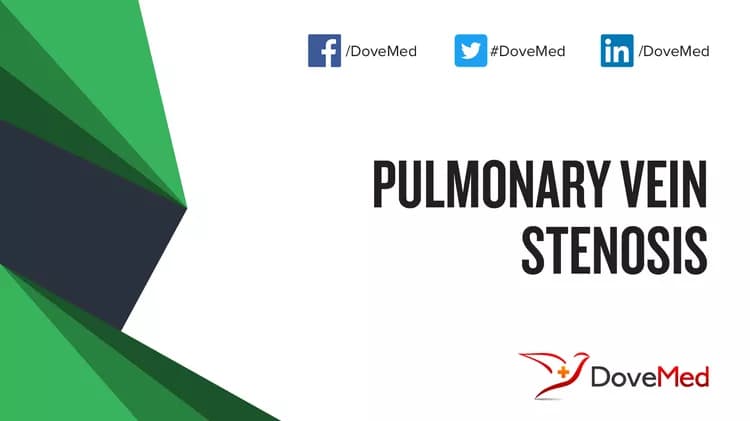What are the other Names for this Condition? (Also known as/Synonyms)
- PVS (Pulmonary Vein Stenosis)
What is Pulmonary Vein Stenosis? (Definition/Background Information)
- Pulmonary Vein Stenosis is a very rare and serious condition in which there is a blockage in the blood vessels that bring oxygen-rich blood from the lungs back to the heart
- This condition can be isolated to one vein, but often affects multiple veins. Stenosis occurs when there is an abnormal thickening and narrowing of the walls of the veins
- Pulmonary Vein Stenosis is a progressive condition and may lead to total obstruction to a blood vessel. Most commonly, all of the pulmonary veins of one lung are affected, causing pulmonary hypertension and pulmonary arterial hypertension
- Surgery and catheterization to widen the narrow veins is usually a short-term solution since the obstruction typically recurs
(Source: Pulmonary Vein Stenosis; Genetic and Rare Diseases Information Center (GARD) of National Center for Advancing Translational Sciences (NCATS), USA.)
Who gets Pulmonary Vein Stenosis? (Age and Sex Distribution)
- Pulmonary Vein Stenosis is a rare disorder of the lungs. The onset of symptoms may occur in infants
- Both males and females may be affected by this condition
- Worldwide, individuals of all races and ethnicities may be affected
What are the Risk Factors for Pulmonary Vein Stenosis? (Predisposing Factors)
The risk factors for Pulmonary Vein Stenosis may include:
- A family history of the condition
- A congenital heart condition
- Constrictive pericarditis
- Chronic lung disease (such as tuberculosis)
- Mediastinitis
- Tumor of the lungs
- Scar tissue formation in the lungs (such as due to a surgery)
It is important to note that having a risk factor does not mean that one will get the condition. A risk factor increases one’s chances of getting a condition compared to an individual without the risk factors. Some risk factors are more important than others.
Also, not having a risk factor does not mean that an individual will not get the condition. It is always important to discuss the effect of risk factors with your healthcare provider.
What are the Causes of Pulmonary Vein Stenosis? (Etiology)
- Pulmonary Vein Stenosis may be caused due to a genetic predisposition (congenital). The exact genetic mutation causing this condition is not known
- PVS may also be caused secondary to pre-existing conditions that may include:
- A congenital heart condition
- Constrictive pericarditis
- Chronic lung disease (such as tuberculosis)
- Mediastinitis
- Tumor of the lungs
- Scar tissue formation
What are the Signs and Symptoms of Pulmonary Vein Stenosis?
The signs and symptoms of Pulmonary Vein Stenosis may come on suddenly, and include:
- Very frequently present symptoms in 80-99% of the cases include hypertension
- Frequently present symptoms in 30-79% of the cases include respiratory insufficiency
- Occasionally present symptoms in 5-29% of the cases include abnormal cardiac septum morphology
(Source: Pulmonary Vein Stenosis; Genetic and Rare Diseases Information Center (GARD) of National Center for Advancing Translational Sciences (NCATS), USA.)
In addition, the following signs and symptoms may be present:
- Poor appetite
- A pale or blue-tinged appearance to the skin
- Rapid heartbeat
- Rapid and shallow breathing
- Recurrent infections
- Bloody cough
- Fatigue
How is Pulmonary Vein Stenosis Diagnosed?
Pulmonary Vein Stenosis is diagnosed on the basis of the following information:
- Complete physical examination
- Thorough medical history evaluation
- Assessment of signs and symptoms
- Laboratory tests
- Imaging studies, such as chest-x-ray
- Electrocardiography
- Biopsy studies, if necessary
Many clinical conditions may have similar signs and symptoms. Your healthcare provider may perform additional tests to rule out other clinical conditions to arrive at a definitive diagnosis.
What are the possible Complications of Pulmonary Vein Stenosis?
The complications of Pulmonary Vein Stenosis may include:
- Progressive worsening of the condition
- Pulmonary edema
- Pulmonary hypertension
- Pulmonary arterial hypertension
- Right heart failure
Complications may occur with or without treatment, and in some cases, due to treatment also.
How is Pulmonary Vein Stenosis Treated?
- The treatment for Pulmonary Vein Stenosis involves surgery and catheterization, in an effort to widen the blocked veins
- Patch grafting and balloon angioplasty for localized stenosis
How can Pulmonary Vein Stenosis be Prevented?
- Currently, there are no methods or guidelines available for the prevention of Pulmonary Vein Stenosis
- Active research is currently being performed to explore the possibilities for treatment and prevention of inherited and acquired genetic disorders
- Regular medical screening at periodic intervals with tests and physical examinations are recommended
What is the Prognosis of Pulmonary Vein Stenosis? (Outcomes/Resolutions)
- Pulmonary Vein Stenosis is a progressive disorder, and the prognosis may be determined by:
- The number of blocked veins
- The extent of blockage
- Severity of signs and symptoms
- Complications, if any
- Responsiveness to treatment
- Without treatment, many affected infants may succumb to the disorder
- There is a likelihood of recurrence, even with treatment
- Typically, the prognosis may be assessed on a case-by-case basis
Additional and Relevant Useful Information for Pulmonary Vein Stenosis:
The following DoveMed website link is a useful resource for additional information:
Related Articles
Test Your Knowledge
Asked by users
Related Centers
Related Specialties
Related Physicians
Related Procedures
Related Resources
Join DoveHubs
and connect with fellow professionals


0 Comments
Please log in to post a comment.